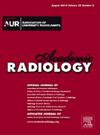放射学学术界代表性不足群体的教师晋升趋势。
IF 3.8
2区 医学
Q1 RADIOLOGY, NUCLEAR MEDICINE & MEDICAL IMAGING
引用次数: 0
摘要
理由和目标:本研究旨在分析放射学学术教师的人口统计学数据,以评估按性别和种族/族裔划分的职级公平性以及 2000 年至 2023 年的趋势:数据收集自美国医学会教职员工薪资名册,该名册收集了美国医学院不同级别教职员工自我报告的性别和种族/族裔信息。为了确定不同性别和种族/族裔教员职级之间的均等性,计算了副教授/助理教授、教授/副教授和教授/助理教授的职级公平指数(REI):女教师的比例从 2000 年的 23.6% 增加到 2023 年的 30%。女性的 REI 稳步上升,白人女性在 2023 年的副教授/助理比较中达到了均等,但在教授/助理比较中没有达到。亚裔和统招女生的 REI 仍然较低(教授/助理比较为 0.67-0.69)。只有亚裔男性在教授/助理比较中达到了均等,而在研究期间,统 一种族男性的 REI 有所下降。黑人教师的 REI 从 2000 年(0.41)到 2009 年(0.67)略有提高,但此后保持不变(2023 年为 0.67):结论:放射学学术梯队的发展并不平衡。尽管随着时间的推移,女性的职级公平性有所改善,但对于统招研究生和亚裔女性而言,其职级公平性仍然远远低于均等水平。实际上,统招男性的职级公平性有所下降。我们需要进一步努力,找出放射学学术界这些亚群体在招聘、留用和晋升方面的障碍,并制定干预措施,使各级放射学教职员工多样化。本文章由计算机程序翻译,如有差异,请以英文原文为准。
Trends in Faculty Advancement for Underrepresented groups in Academic Radiology
Rationale and Objectives
The aim of this study was to analyze demographic data of academic radiology faculty to assess rank equity by gender and race/ethnicity and trends from 2000 to 2023.
Methods
Data was collected from the AAMC Faculty Salary Roster, which collects information for self-reported gender and race/ethnicity for faculty at different ranks in U.S. medical schools. To determine parity between faculty ranks across gender and race/ethnicity, rank equity index (REI) was calculated for associate/assistant, professor/associate, and professor/assistant professor comparisons.
Results
The percentage of women faculty increased from 23.6% in 2000 to 30% in 2023. REI increased steadily for women, and White women reached parity in 2023 for Associate/Assistant comparison but not for Professor/Assistant. REI remained low for Asian and URM women (0.67–0.69 for Professor/Assistant comparison). Only Asian men reached parity for Professor/Assistant comparison, and REI decreased for URM men over the study period. Black faculty had a modest improvement in REI from 2000 (0.41) to 2009 (0.67) but remained unchanged since then (0.67 in 2023).
Conclusion
Advancement along the academic ladder has been uneven in academic radiology. While rank equity for women has improved over time, for URM and Asian women it remains substantially below parity. URM men have actually seen a decline in rank equity across ranks. Further efforts are needed to identify barriers to recruitment, retention, and promotion for these sub-groups in academic radiology and create interventions that diversify radiology faculty at all ranks.
求助全文
通过发布文献求助,成功后即可免费获取论文全文。
去求助
来源期刊

Academic Radiology
医学-核医学
CiteScore
7.60
自引率
10.40%
发文量
432
审稿时长
18 days
期刊介绍:
Academic Radiology publishes original reports of clinical and laboratory investigations in diagnostic imaging, the diagnostic use of radioactive isotopes, computed tomography, positron emission tomography, magnetic resonance imaging, ultrasound, digital subtraction angiography, image-guided interventions and related techniques. It also includes brief technical reports describing original observations, techniques, and instrumental developments; state-of-the-art reports on clinical issues, new technology and other topics of current medical importance; meta-analyses; scientific studies and opinions on radiologic education; and letters to the Editor.
 求助内容:
求助内容: 应助结果提醒方式:
应助结果提醒方式:


